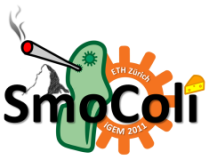Team:ETH Zurich/Biology/MolecularMechanism
From 2011.igem.org
Molecular mechanism
To generate a xylene gradient in our tube we included the upper Tol pathway of Pseudomonas putida in SmoColi. In Pseudomonas putida XylR controls the expression of the xylene degrading enzymes depending on xylene. In our system xylene was used as an input for the bandpass-filter. XylR was constantly expressed and enhances the expression of LacIM1 repressor (codon-modified LacI) and the lambda repressor CI, which are under control of the Xyl-Promotor, respectively. High xylene concentration results in high cytoplasmic levels of CI and of LacIM1 and repression of the green fluorescent protein (GFP). Cells that are far from the input have low xylene concentrations, because of xylene degradation. Accordingly, LacIM1 and CI are only expressed at basal level. Without repression of the lamda promoter wild-type LacI is produced and represses the production of GFP. At the same point the AHL Synthase LuxI is produced, AHL binds to LuxR which is constantly expressed and represses the red florescent protein (RFP). AHL is a quorum-sensing molecule with a high diffusion rate, it diffuses through the whole tube and represses RFP production in the whole tube, even in cells where no AHL is produced. If the xylene concentration is too high and it can not be degraded within the tube, no AHL is produced. Without AHL LuxR does not repress RFP and the whole tube turns red.
 "
"


